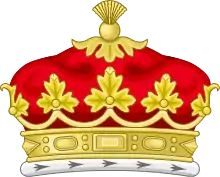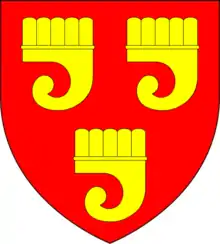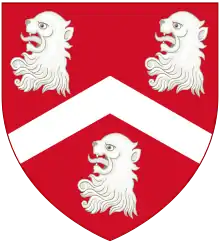Duke of Albemarle
The Dukedom of Albemarle (/ˈælbəˌmɑːrl/) has been created twice in the Peerage of England, each time ending in extinction. Additionally, the title was created a third time by James II in exile and a fourth time by his son the Old Pretender, in the Jacobite Peerage. The name Albemarle is derived from the Latinised form of the French county of Aumale in Normandy (Latin: Alba Marla meaning "White Marl", marl being a type of fertile soil), other forms being Aubemarle and Aumerle.[1] It arose in connection with the ancient Norman Counts of Aumale of Aumale in Normandy. See also Earl of Albemarle.
| Dukedom of Albemarle | |
|---|---|
  | |
| Creation date | 1722 |
| Creation | Fourth |
| Monarch | "James III and VIII" |
| Peerage | Jacobite Peerage |
| First holder | George Granville, 1st Baron Lansdowne, "1st Duke of Albemarle" (1666–1735) |
| Present holder | Exctinct |
| Remainder to | 1st Duke's heirs male of the body lawfully begotten |
| Subsidiary titles | Marquess Monck and Fitzhemon Earl of Bath Viscount Bevil Baron Russell of Lansdowne Baron Lansdown of Bideford |
| Extinction date | 1776 |
| Seat(s) | Albemarle House |
Dukes of Albemarle (Aumale), first creation (1397)
- Edward of Norwich, Duke of Aumale (Albemarle) (1373–1415), grandson of Edward III, was deprived of this dukedom in 1399. He later succeeded his father as Duke of York.[2]
Dukes of Albemarle, second creation (1660)

Arms of Monck: Gules, a chevron between three lion's heads erased argent
- also Earl of Torrington, Baron Monck of Potheridge, Beauchamp and Teyes (England, 7 July 1660)
- George Monck, 1st Duke of Albemarle (1608–1670) was rewarded with his peerages for his part in the Restoration.
- Christopher Monck, 2nd Duke of Albemarle (1653–1688), only son of the 1st Duke, died childless.
Dukes of Albemarle, first Jacobite creation (1696)
- also "Earl of Rochford" and "Baron Romney" (Jacobite, 1696)
- Henry FitzJames, "1st Duke of Albemarle" (1673–1702), illegitimate son of James II was created a peer by his father in exile
Dukes of Albemarle, second Jacobite creation (1722)

Arms of Granville: Gules, three clarions or
- also "Marquess Monck and Fitzhemon", "Earl of Bath", "Viscount Bevil" (Jacobite, 1722), Baron Lansdowne (Great Britain, 1712) and "Baron Lansdown of Bideford" (Jacobite, 1722)
- George Granville, 1st Baron Lansdowne, "1st Duke of Albemarle" (1666–1735), a notable Tory, was made a Jacobite peer by The Old Pretender, which creation was not recognised within the Kingdom of Great Britain.
- Bernard Granville, "2nd Duke of Albemarle" (1700 – 2 July 1776), nephew of Lord Lansdown, allegedly succeeded his uncle in said Jacobite peerage. Never married.[3]
Notes
- Chisholm 1911, p. 492.
- Edward is referred to in Shakespeare's Richard II as the "Duke of Aumerle"
- Bernard Granville, Duke of Albemarle at thepeerage.com (accessed 29 February 2008)
References
- Chisholm, Hugh, ed. (1911). . Encyclopædia Britannica. 1 (11th ed.). Cambridge University Press. pp. 492–493.CS1 maint: ref=harv (link)
- Cokayne, George E. (1910). Gibbs, Vicary (ed.). The complete peerage of England, Scotland, Ireland, Great Britain and the United Kingdom, extant, extinct, or dormant. I, Ab-Adam to Basing. London: St. Catherine Press. pp. 87–91.CS1 maint: ref=harv (link)
- Cokayne, George E. (1998). Hammond, Peter W. (ed.). The complete peerage of England, Scotland, Ireland, Great Britain and the United Kingdom, extant, extinct, or dormant. XIV, Addenda and Corrigenda. London: St. Catherine Press. p. 17.CS1 maint: ref=harv (link)
This article is issued from Wikipedia. The text is licensed under Creative Commons - Attribution - Sharealike. Additional terms may apply for the media files.